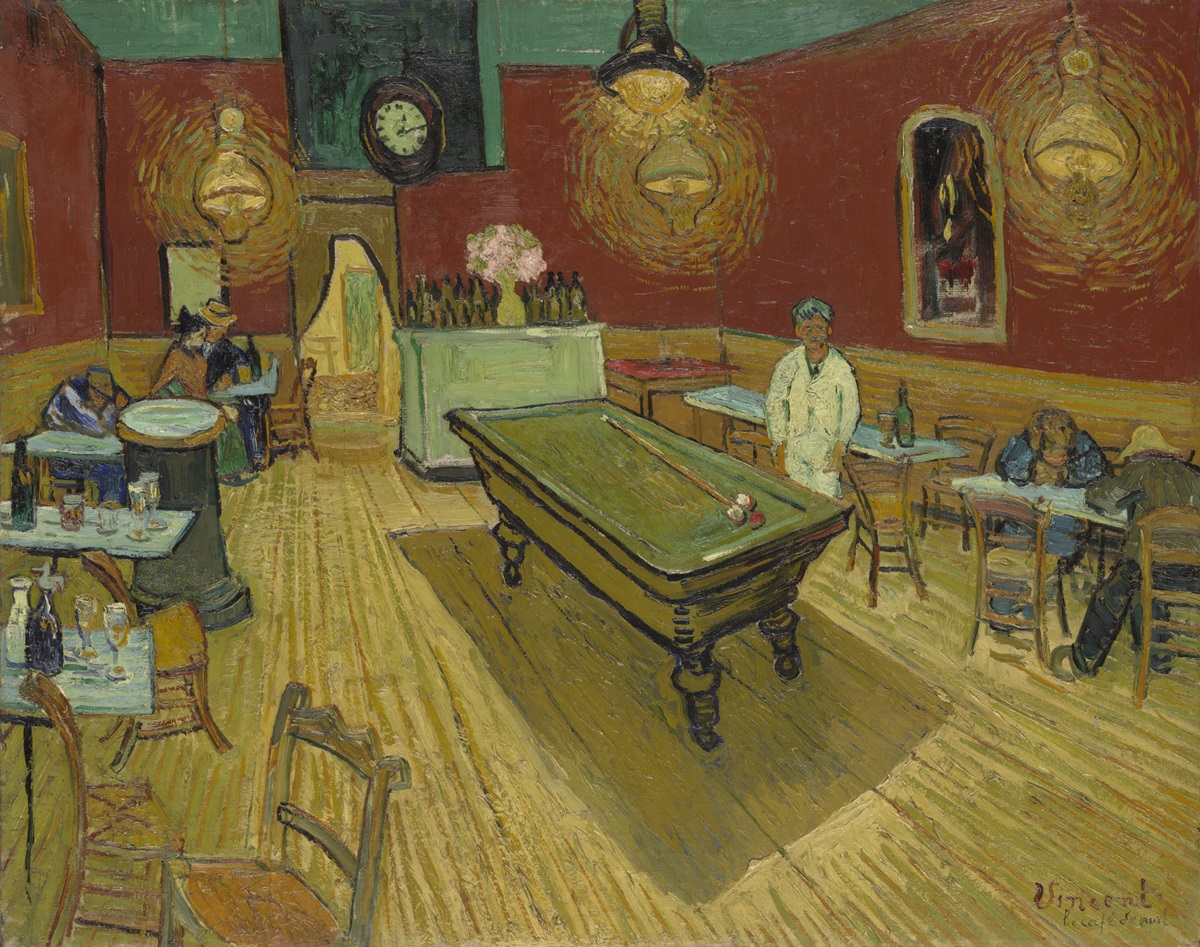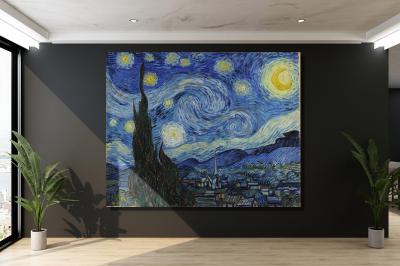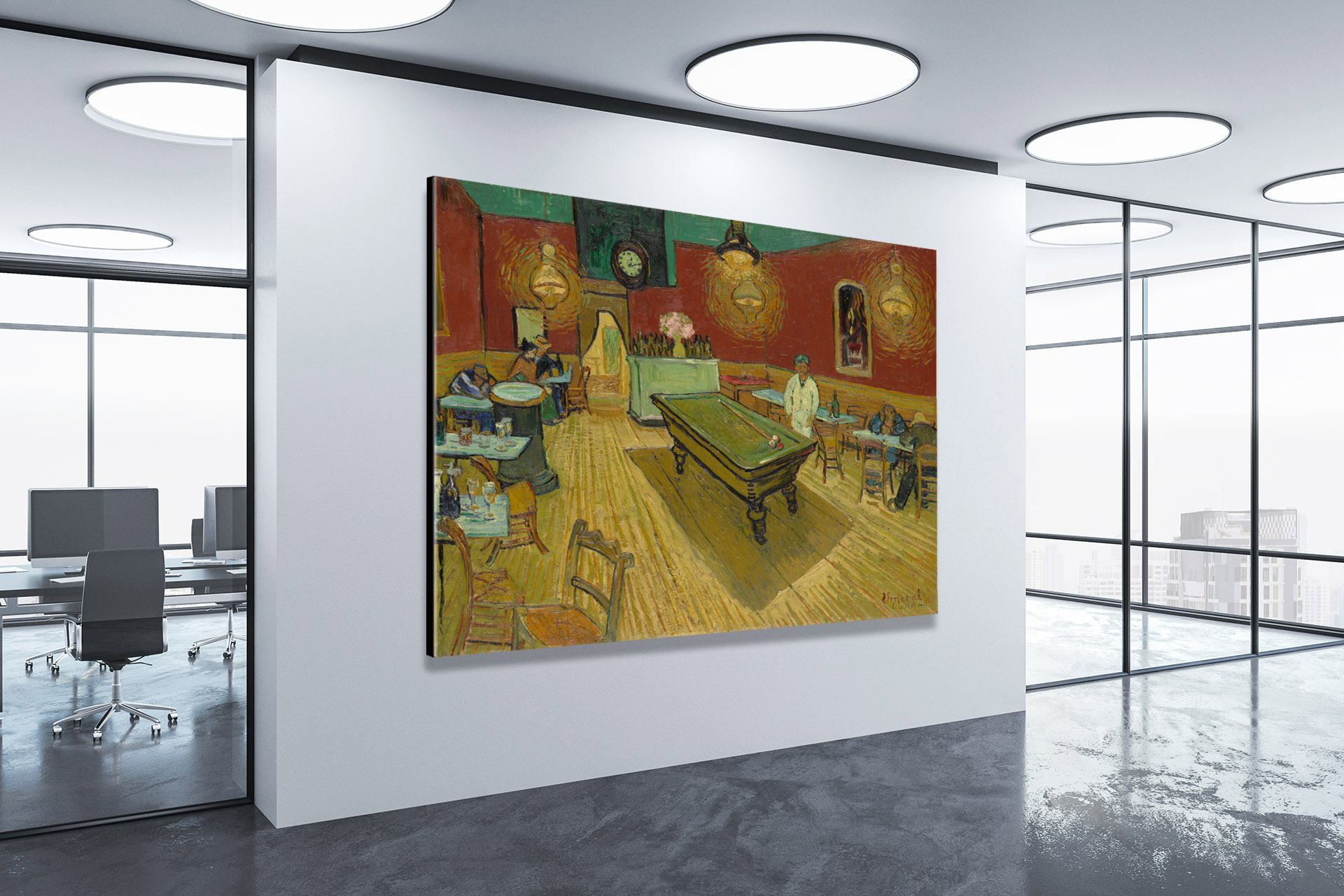Night Cafe
By Vincent van Gogh, 1888
A Deep Dive into the Enigmatic Beauty of Vincent van Gogh’s “Night Cafe”
Within the vast pantheon of art history, there exists a singular name that continues to resonate with unparalleled passion and intrigue: Vincent van Gogh. The Dutch Post-Impressionist maestro left an indelible imprint on the world of art, bestowing us with some of the most celebrated and emotionally charged masterpieces ever created. Among his vast portfolio, there’s one painting that transcends the realms of ordinary canvases, a work that radiates haunting beauty and unadulterated intensity: “Night Cafe.” This canvas, a symphony of colors and emotions, beckons us to embark on a journey deep into the artist’s psyche, enticing us to uncover the profound emotions concealed beneath its surface. In this extensive exploration, we shall dive into the depths of Van Gogh’s “Night Cafe,” shedding light on its intricacies, unraveling the enigmatic tapestry woven by the artist, examining the technical challenges he faced during its creation, and exploring the life and mind of the master himself.
A Glimpse into the Night Cafe
Painted in September 1888 during his sojourn in the picturesque southern French town of Arles, “Night Cafe” was a product of Vincent van Gogh’s firsthand experiences. The scene depicted in the painting was none other than a local establishment that the artist frequented—the Café de l’Alcazar. Yet, what might appear as a straightforward representation of a familiar haunt transforms into an evocative narrative under Van Gogh’s skilled brushwork.
The initial impact of “Night Cafe” is a visceral one, largely attributed to the profound tension created by the artist’s choice of colors. The canvas pulsates with fiery reds, electric yellows, and deep blues, forming a mesmerizing kaleidoscope of emotions. The red floor appears as if it’s bleeding into the walls, imposing a sense of suffocating confinement upon the viewer. Through his mastery of color and brushwork, Van Gogh breathes life into the café’s walls, animating them with an almost palpable restlessness.
“Night Cafe” Large Canvas Prints from WhiteClouds
The Technical Challenges
Van Gogh’s artistic journey was not without its technical challenges, and “Night Cafe” is no exception. The artist’s relentless pursuit of emotional intensity required him to push the boundaries of his craft. He employed thick impasto layers of paint to create the intense texture and depth seen in the painting, a technique that presented its own set of challenges. The heavy impasto required meticulous layering and drying times, testing the artist’s patience and skill.
Moreover, Van Gogh’s endeavor to capture the play of light and shadow in the café was no small feat. His use of contrasting colors and bold strokes demanded precision and dexterity. Each element of the scene, from the swirling patterns on the billiard table to the luminous gas lamps, had to be meticulously crafted to evoke the desired emotional response. The technical intricacies of “Night Cafe” thus underscore Van Gogh’s unwavering dedication to his craft and his relentless pursuit of artistic excellence.
The Human Element
At the core of “Night Cafe” lies a poignant portrayal of the human condition in all its intricate complexity. The figures that populate the scene are solitary, each seemingly entrapped within their own thoughts and emotions. The central character, engrossed in a game of billiards, is isolated in his focused concentration, his countenance bathed in the eerie glow of a gas lamp. The man slouched over the table, lost in contemplation, serves as a poignant reminder of the existential battles waged by individuals.
Van Gogh’s depiction of the café’s inhabitants subtly hints at the isolation and disconnection that plagued him throughout his life. His personal struggles with mental health and his yearning for human connection resonate through the forlorn expressions and the solitary disposition of these characters.
The Battle of Light and Dark
One cannot discuss “Night Cafe” without acknowledging the profound interplay of light and shadow that engulfs the canvas. The stark contrast between the harsh, artificial lighting and the inky darkness that pervades the café interior creates an atmosphere laden with unease. This struggle between light and darkness mirrors the artist’s own inner turmoil, as he grappled with the relentless pursuit of artistic brilliance while wrestling with mental illness.
The swirling patterns of light and shadow that dance across the billiard table, the floor, and the walls seem to convey the restlessness of Van Gogh’s mind itself. It’s as though the artist’s inner demons have materialized within the very ambiance of the café, turning it into a battleground of conflicting emotions.
The Location of the Painting
The choice of location for “Night Cafe” is significant in understanding its context. Arles, a quaint town in the South of France, held a special place in Van Gogh’s heart. He had moved there to escape the frenetic pace of Paris and to immerse himself in the vibrant colors and landscapes of the Provençal countryside. The Café de l’Alcazar, depicted in the painting, was a place of refuge and inspiration for the artist.
The café’s atmosphere, filled with the aroma of coffee and the chatter of patrons, was a welcome respite for Van Gogh. It was in this very locale that he sought solace and social interaction, albeit fleeting, during his turbulent journey. The choice of this particular venue as the subject of “Night Cafe” reflects Van Gogh’s deep connection to his surroundings and his unrelenting desire to capture the essence of the moment.
The Painter: Vincent van Gogh
Vincent van Gogh, born in the Netherlands in 1853, was a complex and enigmatic figure in the world of art. His life was marked by struggles, both personal and artistic. Van Gogh’s early years were filled with various careers, including being a preacher and an art dealer, before he eventually devoted himself to painting. His work was heavily influenced by the Post-Impressionist movement, characterized by a focus on emotional depth and vibrant color.
Throughout his life, Van Gogh grappled with mental health issues, which often manifested in periods of extreme anxiety and depression. His emotional turmoil is palpable in many of his works, including “Night Cafe.” Despite his challenges, Van Gogh produced an astonishing body of work in just a decade, including some of the most iconic paintings in art history.
Vincent van Gogh’s tragic end came in 1890 when he took his own life at the age of 37. While he did not achieve commercial success during his lifetime, his posthumous recognition as a visionary artist solidified his place in art history.
 Night Cafe by Vincent van Gogh
Night Cafe by Vincent van Gogh
Conclusion
Vincent van Gogh’s “Night Cafe” is not just a painting; it’s a portal to another dimension, a dimension that transcends the boundaries of time and space. It beckons us to explore the profound depths of the human experience through the eyes of a tormented artist. With its vivid palette, poignant exploration of solitude, the captivating interplay of light and darkness, and the technical challenges faced by the artist, this masterpiece serves as a haunting reminder of the inner turmoil that fueled Van Gogh’s creativity. It challenges us to confront our own inner demons and ponder the profound mysteries of the human soul. In the end, “Night Cafe” is not merely a work of art; it’s a profound insight into the tortured genius of one of history’s most celebrated artists, forever echoing in the annals of art history.
Frequently Asked Questions About “Night Cafe”
1. What is the significance of “Night Cafe” in the context of Vincent van Gogh’s body of work? “Night Cafe” is significant in Vincent van Gogh’s body of work as it represents his use of color to convey emotion and his exploration of the human condition.
2. Where is “Night Cafe” currently housed or displayed? “Night Cafe” is currently housed in the Yale University Art Gallery in New Haven, Connecticut, USA.
3. What was the inspiration behind the creation of “Night Cafe”? The inspiration behind “Night Cafe” was the actual Café de l’Alcazar in Arles, France, which Van Gogh frequented during his time there.
4. Can you explain the symbolism of the colors used in the painting, especially the dominant reds and yellows? The dominant reds and yellows in the painting are believed to represent the intensity of human emotions, such as passion, loneliness, and despair. The colors create a sense of unease and restlessness.
5. What technical challenges did Vincent van Gogh face while painting “Night Cafe,” and how did he overcome them? Vincent van Gogh faced technical challenges in “Night Cafe” due to his use of thick impasto layers of paint and the need for precision in depicting light and shadow.
6. How does “Night Cafe” reflect the artist’s personal struggles and mental state at the time of its creation? “Night Cafe” is often seen as reflecting Van Gogh’s personal struggles with mental health, as the scene conveys a sense of isolation and inner turmoil.
7. What is the historical and cultural context of the Arles region in France where “Night Cafe” was painted? The historical and cultural context of the Arles region in France was one of inspiration for Van Gogh, with its vibrant colors and landscapes influencing his work during his time there.
8. Are there any known interpretations or analyses of “Night Cafe” by art historians or critics? Art historians and critics have offered various interpretations of “Night Cafe,” including its representation of existential themes and the human condition.
9. How has “Night Cafe” influenced other artists or art movements? “Night Cafe” has influenced other artists and art movements, particularly in its use of bold colors and emotional intensity.
10. Are there any interesting anecdotes or stories related to the creation or reception of “Night Cafe” by Vincent van Gogh? Anecdotes related to “Night Cafe” include Van Gogh’s own description of the painting as “one of the ugliest pictures I have done” and the reaction of his friend and fellow artist, Paul Gauguin, to the work.
11. Has “Night Cafe” undergone any significant restoration or conservation efforts? “Night Cafe” has undergone some restoration efforts to preserve the artwork, but its overall condition remains relatively stable.
12. What is the estimated value of “Night Cafe” in today’s art market? The estimated value of “Night Cafe” in today’s art market is not publicly disclosed, as it is part of a museum collection.
13. How has the public’s perception and appreciation of “Night Cafe” evolved over time? The public’s perception and appreciation of “Night Cafe” have evolved over time, with the painting gaining greater recognition and significance in the art world.
14. Are there any other artworks or artists that can be compared or contrasted with “Night Cafe” to gain a deeper understanding of its significance? “Night Cafe” can be compared to other Van Gogh works like “Café Terrace at Night” for its thematic similarities and differences in style.
15. How can one experience “Night Cafe” in person or through reproductions, and what impact does viewing it in different formats have on the viewer’s understanding and appreciation of the artwork? “Night Cafe” can be experienced in person at the Yale University Art Gallery, and reproductions are available in various formats. Viewing it in person offers a more intimate and immersive experience.
16. What impact has “Night Cafe” had on the broader art world and popular culture? “Night Cafe” has had a significant impact on the art world and has become an iconic representation of Van Gogh’s unique style and emotional depth.
17. Are there any ongoing research or scholarly studies related to “Night Cafe” that are contributing to our understanding of the artwork and its creator? Ongoing research and scholarly studies related to “Night Cafe” continue to contribute to our understanding of the painting, its symbolism, and its place in Van Gogh’s artistic journey.
Other Articles on Vincent van Gogh Paintings
At Eternities Gate by Vincent Van Gogh, 1890
Blossoming Almond Tree by Vincent Van Gogh, 1890
Cafe Terrace at Night by Vincent Van Gogh, 1888
Daubigneys Garden by Vincent Van Gogh, 1890
Green Wheat Field with Cypress by Vincent Van Gogh, 1889
Houses at Auvers by Vincent Van Gogh, 1890
Irises by Vincent Van Gogh, 1889
Night Café by Vincent Van Gogh, 1888
Portrait of Dr. Gachet by Vincent Van Gogh, 1890
Red Vineyards by Vincent Van Gogh, 1888
Road with Cypress and Star by Vincent Van Gogh, 1890
Starry Night by Vincent Van Gogh, 1889
Starry Night over the Rhone by Vincent Van Gogh, 1888
Sunflowers by Vincent Van Gogh, 1887
The Bedroom by Vincent Van Gogh, 1888
The Church at Aurers by Vincent Van Gogh, 1890
The Garden of the Asylum by Vincent Van Gogh, 1889
The Mulberry Tree by Vincent Van Gogh, 1889
The Potato Eaters by Vincent Van Gogh, 1885
The Yellow House by Vincent Van Gogh, 1888
Tree Roots by Vincent Van Gogh, 1890
Van Gogh Self Portrait by Vincent Van Gogh, 1887
Vase with Red Poppies by Vincent Van Gogh, 1886
View of Arles by Vincent Van Gogh, 1889
Wheat Field with Crows by Vincent Van Gogh, 1890
Wheat Field with Cypresses by Vincent Van Gogh, 1889
More WhiteClouds Videos
Contact us today to learn more about our 3D services and how we can help you achieve your goals.

